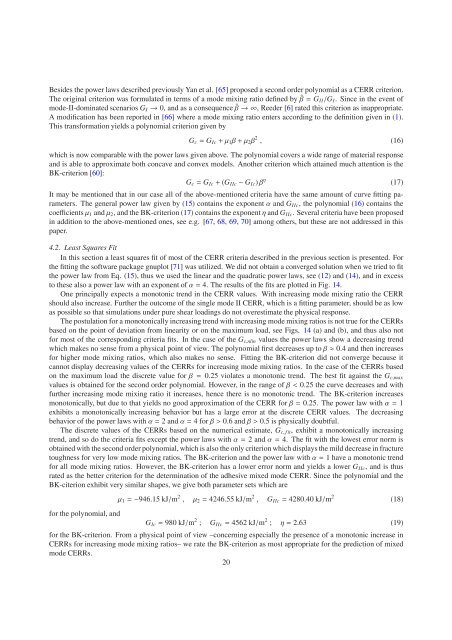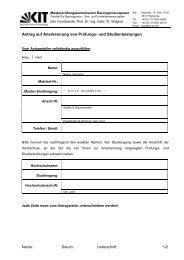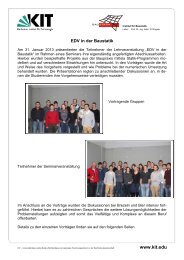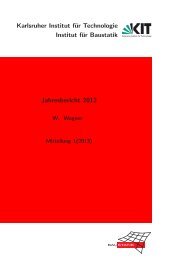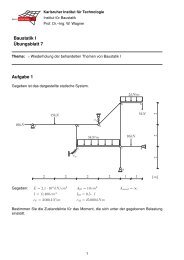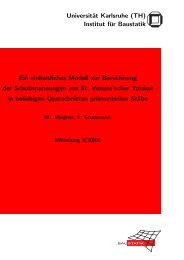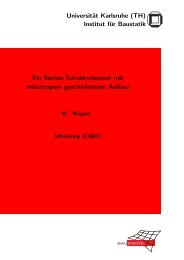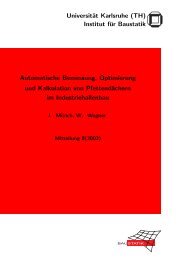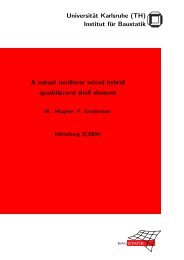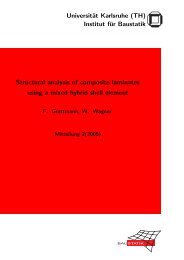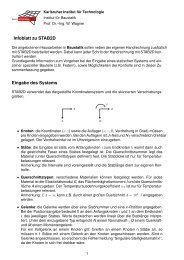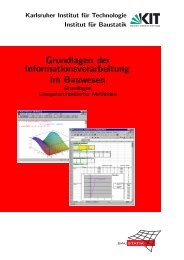Karlsruher Institut für Technologie Institut für Baustatik Adhesive ...
Karlsruher Institut für Technologie Institut für Baustatik Adhesive ...
Karlsruher Institut für Technologie Institut für Baustatik Adhesive ...
- No tags were found...
Create successful ePaper yourself
Turn your PDF publications into a flip-book with our unique Google optimized e-Paper software.
Besides the power laws described previously Yan et al. [65] proposed a second order polynomial as a CERR criterion.The original criterion was formulated in terms of a mode mixing ratio defined by ˆβ = G II /G I . Since in the event ofmode-II-dominated scenarios G I → 0, and as a consequence ˆβ →∞, Reeder [6] rated this criterion as inappropriate.A modification has been reported in [66] where a mode mixing ratio enters according to the definition given in (1).This transformation yields a polynomial criterion given byG c = G Ic + μ 1 β + μ 2 β 2 , (16)which is now comparable with the power laws given above. The polynomial covers a wide range of material responseand is able to approximate both concave and convex models. Another criterion which attained much attention is theBK-criterion [60]:G c = G Ic + (G IIc − G Ic ) β η (17)It may be mentioned that in our case all of the above-mentioned criteria have the same amount of curve fitting parameters.The general power law given by (15) contains the exponent α and G IIc , the polynomial (16) contains thecoefficients μ 1 and μ 2 , and the BK-criterion (17) contains the exponent η and G IIc . Several criteria have been proposedin addition to the above-mentioned ones, see e.g. [67, 68, 69, 70] among others, but these are not addressed in thispaper.4.2. Least Squares FitIn this section a least squares fit of most of the CERR criteria described in the previous section is presented. Forthe fitting the software package gnuplot [71] was utilized. We did not obtain a converged solution when we tried to fitthe power law from Eq. (15), thus we used the linear and the quadratic power laws, see (12) and(14), and in excessto these also a power law with an exponent of α = 4. The results of the fits are plotted in Fig. 14.One principally expects a monotonic trend in the CERR values. With increasing mode mixing ratio the CERRshould also increase. Further the outcome of the single mode II CERR, which is a fitting parameter, should be as lowas possible so that simulations under pure shear loadings do not overestimate the physical response.The postulation for a monotonically increasing trend with increasing mode mixing ratios is not true for the CERRsbased on the point of deviation from linearity or on the maximum load, see Figs. 14 (a) and (b), and thus also notfor most of the corresponding criteria fits. In the case of the G c,nlin values the power laws show a decreasing trendwhich makes no sense from a physical point of view. The polynomial first decreases up to β ≈ 0.4 and then increasesfor higher mode mixing ratios, which also makes no sense. Fitting the BK-criterion did not converge because itcannot display decreasing values of the CERRs for increasing mode mixing ratios. In the case of the CERRs basedon the maximum load the discrete value for β = 0.25 violates a monotonic trend. The best fit against the G c,maxvalues is obtained for the second order polynomial. However, in the range of β0.6andβ>0.5 is physically doubtful.The discrete values of the CERRs based on the numerical estimate, G c, fit , exhibit a monotonically increasingtrend, and so do the criteria fits except the power laws with α = 2andα = 4. The fit with the lowest error norm isobtained with the second order polynomial, which is also the only criterion which displays the mild decrease in fracturetoughness for very low mode mixing ratios. The BK-criterion and the power law with α = 1 have a monotonic trendfor all mode mixing ratios. However, the BK-criterion has a lower error norm and yields a lower G IIc , and is thusrated as the better criterion for the determination of the adhesive mixed mode CERR. Since the polynomial and theBK-citerion exhibit very similar shapes, we give both parameter sets which areμ 1 = −946.15 kJ/m 2 , μ 2 = 4246.55 kJ/m 2 , G IIc = 4280.40 kJ/m 2 (18)for the polynomial, andG Ic = 980 kJ/m 2 ; G IIc = 4562 kJ/m 2 ; η = 2.63 (19)for the BK-criterion. From a physical point of view –concerning especially the presence of a monotonic increase inCERRs for increasing mode mixing ratios– we rate the BK-criterion as most appropriate for the prediction of mixedmode CERRs.20


